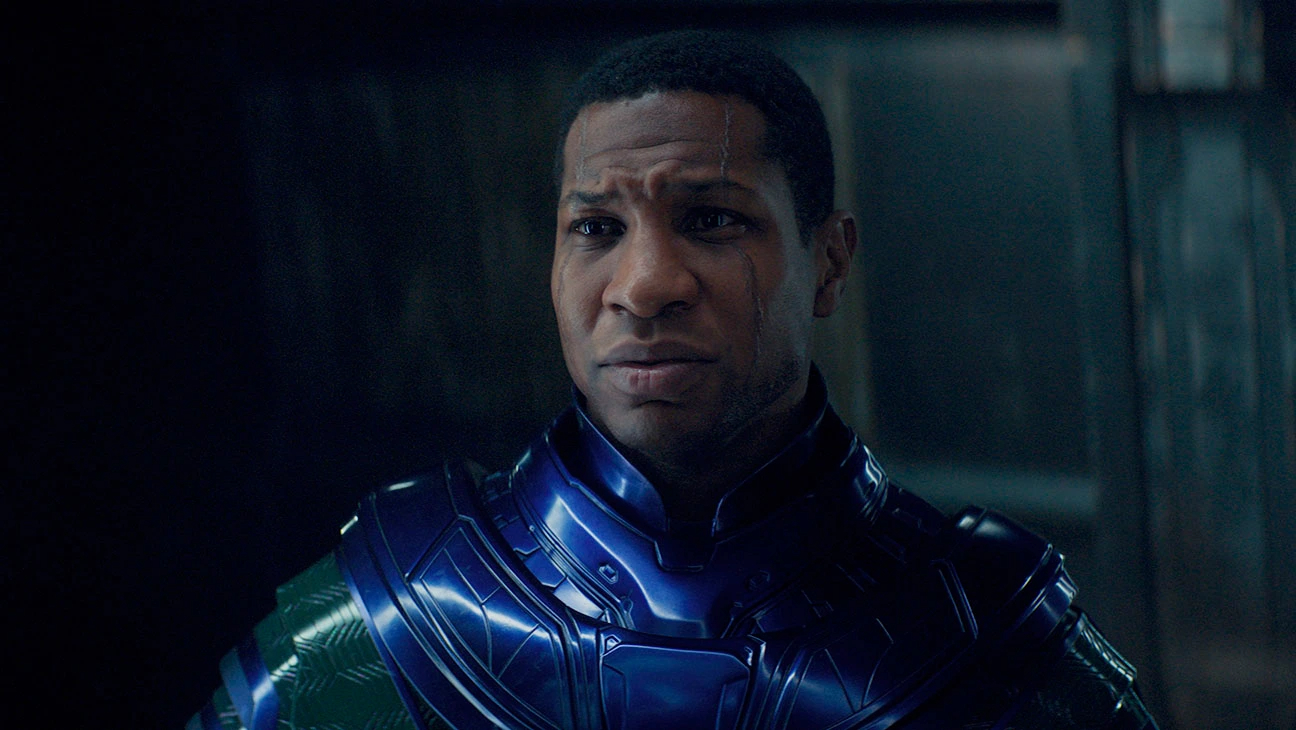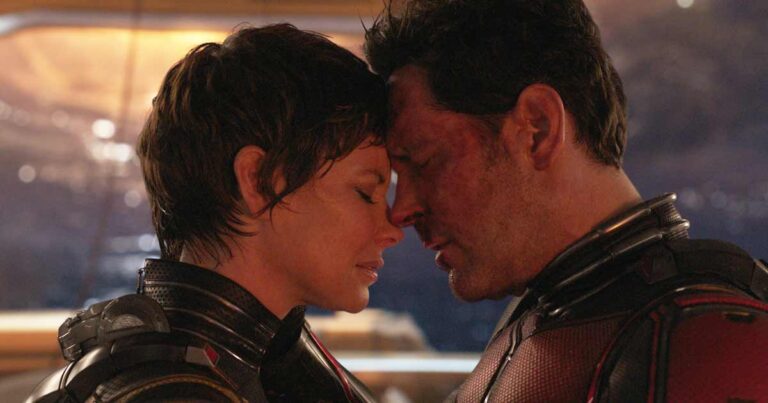Set in the aftermath of the tumultuous events of 2019’s Avengers: Endgame, the third installment of the Ant-Man franchise, and the beginning of Marvel Studios’ Phase Five, wastes no time getting to the heart of the action, and more importantly, a proper introduction to the new “big bad.” Unfortunately, Phase Five starts not with a bang, but with a mess of characterization, pacing, and green-screen level CGI. Ant-Man and the Wasp: Quantumania loses sight of its characters, and in the process delivers a final product devoid of meaningful stakes and filled with lackluster action.
After saving the world (again) Scott Lang, (Paul Rudd) is on cloud nine. He’s enjoying the perks of being an avenger, going on book tours, and spending time with his girlfriend Hope (Evangeline Lilly) and daughter Cassie (Kathryn Newton). After Cassie creates a device intended to study the Quantum Realm, Scott, Hope, Cassie along with Hank Pym (Michael Douglas) and Janet Van Dyne (Michelle Pfeiffer) are inadvertently trapped in this other dimension. Once stranded there, Janet admits that during her last 30-year stint stuck in the realm, she wasn’t exactly alone, or innocent. Scott and his allies must band together to stop a new Avengers-level threat, Kang the Conqueror (Johnathan Majors), from escaping and destroying the multiverse.

The main overall issue with the film is that Ant-Man is not a cosmic hero. In the previous two Ant-Man films, the character was up against ordinary people who had gotten their hands on some Pym technology. The previous exploits of the character kept at least one foot grounded in science. Fake superhero science, yes, but at least there was some sort of reality check. Kang, however, is a villain firmly rooted in the cosmic and mystical side of the Marvel canon. Kang is a time-traveling, multiverse destroying, extraordinary villain. The seriousness of the new Thanos-level threat just doesn’t fit with Scott’s lighthearted nature. The overall pacing and humor would have worked better if the setting had stuck to Ant-Man’s familiar territory of San Francisco, or at least Earth. Another major characterization fail is Hope Van Dyne, aka The Wasp. Despite her name being in the title, she is just kind of there throughout the film. In previous installments, The Wasp was being set up as a strong, female hero, and her love story with Scott was heartwarming. But with five main heroes, there just isn’t enough time to devote to giving each character equal development, and unfortunately Hope is a victim of that.
Another character introduced in this film is MODAK. MODAK is a popular and well-known villain from the comics, best known for being a giant floating head. Seeing MODAK in live action was always guaranteed to be nightmare-inducing, and not in a good way. MODAK is a character that just can’t be taken seriously, and the film does at least get that part right. However, being the right-hand man to Kang, a character that Johnathan Majors plays as serious as a heart attack, makes the ridiculousness of the character stick out like a sore thumb. The MCU wasted this beloved character by putting him in this movie, when he would probably have been better served antagonizing War Machine or another Iron-man related hero, like in his comics roots.
Marvel Studios has made a name for themselves mixing super heroic action with humor since the dawn of their cinematic universe. This formula usually works and worked really well in the two previous Ant-Man movies. But Quantumania tried to use the same formula, and it just didn’t work this time. Seriously, no joke about holes should go on that long. Scott Lang is a funny character, and the first ten or so minutes before they entered the Quantum realm did a great job balancing humor and plot. But once Scott and crew enter the CGI-laden spectacle of the Quantum realm, all humor goes out the window and everything just seems to drag on. It almost feels like the movie was written by two separate people. One who was familiar with Ant-Man as a character, but who only got to write the beginning and ending, and someone else with no knowledge of previous movies got to write the rest. It is almost hard to believe that Peyton Reed directed all three films in this trilogy, with how out of touch this third installment is with the other two.

Speaking of the titular Quantum Realm, it looked… fine? It’s to be understood that a movie set almost entirely in a fictional dimension will be CGI heavy, but here it felt so noticeable. The overall effect was reminiscent of a green screen, which makes it difficult to be immersed in the world. There have already been several Spy Kids comparisons, and for a film that cost $200 million, that’s not great. The other thing is that the main CGI spectacle in the Ant-Man movies is the fact that the characters can grow and shrink. Not to say that there isn’t plenty of that, but when everyone is already shrunk down just to be in the Quantum Realm, that power isn’t used as often.
The MCU is no stranger to recasts that usually work out for the better, (Cough cough Mark Ruffalo). Scott’s daughter has now been portrayed by three actresses in the MCU, Abby Ryder Fortson, Emma Fuhrmann and now Kathryn Newton. With the time jump that occurs in Endgame, it makes sense that a new actress would be needed to portray time having passed, and Cassie getting older. However, it is unclear why exactly the character was recast between Avengers: Endgame and Ant-Man and the Wasp: Quantumania. Even though Emma Fuhrmann had such a short amount of screen time, compared to Kathryn Newton’s role as one of the main characters, Emma played a superior Cassie. Cassie Lang in this film seemed one-dimensional, and hard to empathize with. Despite Scott’s claim he wanted to be there for his daughter, neither character seemed invested in the other’s wellbeing. Much like Hope, Cassie was just sort of there. She helped take down some enemies, sure, but it would have been nice to see the character have more agency, rather than being there to move along Scott’s story.

The one aspect saving this from being a one-star review is Jonathan Majors’ performance as Kang the Conqueror. As previously mentioned, Kang is shaping up to be the Thanos of this saga of the MCU. And Jonathan Majors fills those shoes perfectly. Somehow, he manages to top his performance as He-Who-Remains in the Loki television series, portraying a manipulative and terrifying villain. Whatever lies next for the emerging Multiverse saga, Kang will undoubtedly be at the center, and could be the one to uplift what would otherwise be mediocre storytelling.
If the MCU was written off after a single critical flop, Thor: The Dark World would have brought everything crashing down. But Marvel persisted, and because of that audiences got the incredible films of phases three and four, culminating in a beautiful send off to the Infinity Saga. The MCU’s next two theatrical releases (Guardians of the Galaxy vol. 3 and The Marvels) are not intricately intertwined with the overarching multiverse saga, and one can hope this improves their overall quality. Hopefully 2025’s Avengers: The Kang Dynasty is a good enough movie that makes the two hours of half-baked plot and green-screen graphics of Ant-Man 3 worth it.
2/5 Stars

thanks alot of information keren